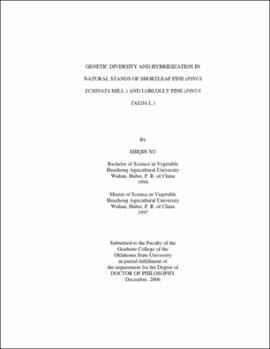| dc.contributor.advisor | Tauer, Charles G. | |
| dc.contributor.author | Xu, Shiqin | |
| dc.date.accessioned | 2013-11-26T08:26:11Z | |
| dc.date.available | 2013-11-26T08:26:11Z | |
| dc.date.issued | 2006-12 | |
| dc.identifier.uri | https://hdl.handle.net/11244/6851 | |
| dc.description.abstract | Scope and Method of Study: molecular markers (AFLPs and IDH), population genetics, conversation, forest genetics. | |
| dc.description.abstract | Findings and Conclusions: Genetic diversity in natural stands of shortleaf pine and loblolly pine is high. The majority (over 80%) of this genetic diversity is found within subpopulations and less than 20% is found among subpopulations. The subpopulations in both shortleaf pine and loblolly pine have similar level of genetic diversity. The populations located east of the Mississippi River and those west of the River have similar level of genetic diversity. Gene flow is high among subpopulations and between populations east and west of the Mississippi River. No apparent relationship exists between populations' geographic distances and genetic distances. The hybridization rate between the two species varies from place to place, ranging from 25% in MO to 0 in other populations in this study. The hybridization frequency is higher in populations west of Mississippi River than in those east of the River. IDH is a useful marker to detect hybrids of shortleaf and loblolly pine. AFLPs are good markers for genetic diversity and structure study, but not efficient in finding later generation hybrids. More codominant markers are needed to detect later generation hybrids. The results of this study may have important forest management implications. | |
| dc.format | application/pdf | |
| dc.language | en_US | |
| dc.rights | Copyright is held by the author who has granted the Oklahoma State University Library the non-exclusive right to share this material in its institutional repository. Contact Digital Library Services at lib-dls@okstate.edu or 405-744-9161 for the permission policy on the use, reproduction or distribution of this material. | |
| dc.title | Genetic diversity and hybridization in natural stands of shortleaf pine (Pinus echinata Mill.) and loblolly pine (Pinus taeda L.) | |
| dc.contributor.committeeMember | Martin, Bjorn | |
| dc.contributor.committeeMember | Huang, Yinghua | |
| dc.contributor.committeeMember | Porter, David | |
| osu.filename | Xu_okstate_0664D_2071.pdf | |
| osu.accesstype | Open Access | |
| dc.type.genre | Dissertation | |
| dc.type.material | Text | |
| thesis.degree.discipline | Plant Science | |
| thesis.degree.grantor | Oklahoma State University | |
